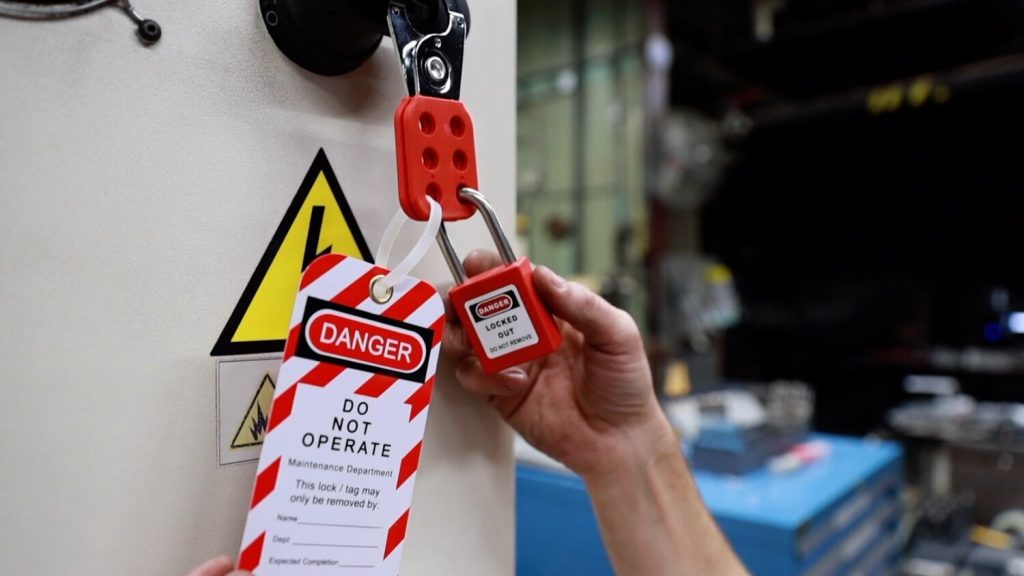The Lockout/Tagout (LOTO) standard covers the servicing and maintenance of machines and equipment in which the unexpected startup of the machines or equipment, or release of stored energy could cause injury to employees. Machines that start up unexpectedly while being serviced can cause severe injury or even death. Energy sources may include: electrical, mechanical, hydraulic, pneumatic, chemical, nuclear, thermal, or other energy.
Lockout/tagout must be applied when servicing and/or maintenance take place during normal production operations and are covered by this standard if:
- An employee is required to remove or bypass a guard or other safety device; or
- An employee is required to place any part of his or her body into an area on a machine or piece of equipment where work is actually performed upon the material being processed (point of operation) or where an associated danger zone exists during a machine operating cycle.
Note: Guards removed in both cases above (LOTO applies)
To prevent injuries workers should always release any residual/stored/potential (capacitors, gravity, hydraulics, etc.) energy and lockout any sources of energy (circuit breaker, wall switch, valve, etc.).
DEFINITIONS:
Affected Employee is an employee whose job requires him/her to operate or use a machine/equipment on which servicing or maintenance is being performed under lockout or tagout. Affected Employees must receive training on the purpose and use of the energy control procedure.
Authorized Employee is an employee who locks out or tags out machines or equipment in order to perform servicing or maintenance on that machine or equipment. Authorized Employees must receive training on the recognition of applicable hazardous energy sources, the type, and magnitude of the energy available in the workplace, and the methods and means necessary for energy isolation and control.
Lockout – The placement of a lockout device on an energy isolating device, in accordance with an established procedure, ensures that the energy isolating device and the equipment being controlled cannot be operated until the lockout device is removed.
A Lock-out device is a locking device that provides a means for rendering a switch, valve, or any energy source inoperable. The device may be a padlock, chain, or any device that positively prevents a machine or piece of equipment from becoming “energized” or from releasing stored energy.
Other Employee – is an employee that may be in the area where lockout/tagout is being applied. Other Employees must be informed of the LOTO procedures being performed in their work areas and must be instructed not to energize equipment being serviced.
Tagout – the placement of a tagout device on an energy isolating device, in accordance with an established procedure, to indicate that the energy isolating device and the equipment being controlled may not be operated until the tagout device is removed.
A Tag-out device is a means of identifying who locked out the machinery, the date and time of day the lockout took place, and the department for which the person works. Tags must be durable and be securely fastened to the locking mechanism so as not to fall off.
6 STEPS TO LOCKOUT/TAGOUT
To safely apply energy control to machines or equipment (using either lockout or tagout devices), authorized employees must perform certain procedures, in a specific order.
- Preparation for shutdown: Before an authorized or affected employee turns off a machine or equipment, the authorized employee must have knowledge of the type and magnitude of the energy, the hazards of the energy to be controlled, and the method or means to control the energy. He must also notify all “affected” and “other” employees of the process.
- Alert employees that the machine or equipment will be LOTO.
- Machine or equipment shutdown: The machine or equipment must be turned off or shut down using the procedures established for it to avoid any additional or increased hazards to employees as a result of the machine or equipment stoppage.
- Machine or equipment isolation: All energy isolating devices that are needed to control the machine’s energy source must be located. These devices must then be used to isolate the machine or equipment from its energy source.
- Lockout or tagout device application:
- Authorized employees must affix lockout or tagout devices to each energy- isolating device.
- Each authorized employee shall place his/her own personal lockout device or tagout device on the energy isolating device(s).
- When an energy-isolating device cannot accept multiple locks or tags, a multiple lockout or tagout device (hasp) may be used.
- If lockout is used, a single lock may be used to lockout the machine or equipment with the key being placed in a lockout box or cabinet which allows the use of multiple locks to secure the box or cabinet.
- Each authorized employee shall then use his/her own lock to secure the box or cabinet.
- Lockout devices when used must be affixed in a manner that shall hold the energy isolating devices in a “safe” or “off” position.
- Where tagout devices are used, it must be affixed in a manner that shall clearly indicate that the operation or movement of energy isolating devices from the “safe” or “off” position is prohibited. Where tagout devices are used with energy isolating devices designed with the capability of being locked, the tag attachment shall be fastened at the same point at which the lock would have been attached.
- If the tag cannot be affixed directly to the energy isolating device, the tag must be located as close as safely possible to the device, in a position that shall be immediately obvious to anyone attempting to operate the device.
- Stored energy: After the energy isolating device has been locked out or tagged out, all potentially hazardous stored or residual energy must be relieved, disconnected, restrained, or otherwise rendered safe. If there is a possibility of re-accumulation of stored energy to a hazardous level, verification of isolation shall be continued until the servicing or maintenance is completed, or until the possibility of such accumulation no longer exists. Stored energy can be found in capacitors, springs and elevated components.
- Verification of isolation: Before any work begins on machines or equipment that have been locked out or tagged out, an authorized employee must verify that the machine or equipment has been properly isolated and de-energized. Try to start the machine (i.e. press the start button); if the machine starts your procedures are not appropriate. Test for the absence of voltage.
COMMONLY USED DEVICES
- Multiple lock hasp
- Breaker lockout device
- Plug and cord lockout device
- Valve lockout device
Equipment must be in a ZERO energy state before employees are allowed to service them. These devices help maintain ZERO energy by rendering a switch, valve, or any energy source inoperable.
Devices used for lockout/tagout must:
- Must be durable, so that they are capable of withstanding the environment to which they are exposed for the maximum period of time that exposure is expected.
- Must be singularly identified.
- Must be the only devices used for controlling energy.
- Must not be used for other purposes.
- Must be standardized within the facility in at least one of the following criteria: color, shape, or size. Additionally, tagout devices must be standardized as to print and format
- Must be identifiable, in that it indicates the identity of the employee applying the devices
BREWERY SPECIFIC EXAMPLES
A couple of brewery specific examples include working in a mash tun with rakes and boil kettles. One thing that is important to keep in mind is that all over your breweries are pieces of equipment that both your LOTO and Confined Space Entry programs must be used to ensure safe work and/or repairs. Both of these specific examples fall under this ideal. Obviously climbing in a mash tun with the rakes able to be activated and cause injury falls under both programs. The same goes for climbing in a boil kettle for cleaning or repairs when the heat source can be turned on causing severe burning or even death. These are just a couple of examples in a brewery full of equipment that must be treated with respect to avoid injuries or worse.
RELEASE FROM LOCKOUT/TAGOUT
The Lockout/Tagout standard includes requirements for releasing machines or equipment that have been locked out or tagged out prior to restoring energy to the equipment and using it. Before lockout or tagout devices are removed, and energy restored, an authorized employee must complete certain procedures.
- Machine/equipment inspection: The work area must be inspected to ensure that nonessential items (e.g., tools, spare parts) have been removed and that all of the machine or equipment components are operationally intact.
- Positioning of employees: The work area must be checked to ensure that all employees have been safely positioned or have cleared the area. In addition, all affected employees must be notified that the lockout or tagout devices have been removed before the equipment is started.
- Lockout or tagout device removal: Each lockout or tagout device must be removed from the energy-isolating device by the employee who applied the device.
ENERGY CONTROL PROCEDURES DOCUMENTATION
Employers must develop, document, and use specific procedures to control potentially hazardous energy when employees are servicing equipment or machinery.
The procedures must outline the scope, purpose, authorization, rules, and techniques that the employer shall use to control hazardous energy and must state the means to be used to enforce compliance.
TRAINING AND COMMUNICATION
Employees must be trained so that they understand the purpose and function of the energy control program and acquire the knowledge and skills necessary for the safe application, usage, and removal of the energy controls.
Another important aspect of proper LOTO training that most businesses don’t consider are vendors and contractors. It is your responsibility to make sure that any outside people doing work in your facility are made aware of your safety policies.
PERIODIC INSPECTIONS
All written procedures must be inspected at least annually. The purpose of this inspection is to identify errors in the content of procedure itself, and to verify employees’ understanding of and compliance with procedures.
Last but not least, here are a couple of links from OSHA to help get you started with a LOTO plan of your own.
OSHA 1910.147: The Control of Hazardous Energy (Lockout/Tagout)
OSHA 1910.147: Typical Minimal Lockout Procedure
Written by Jason Ford – Broken Compass Brewing – Breckenridge, CO









